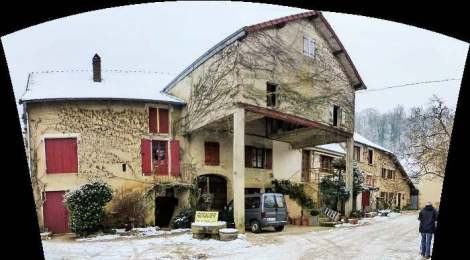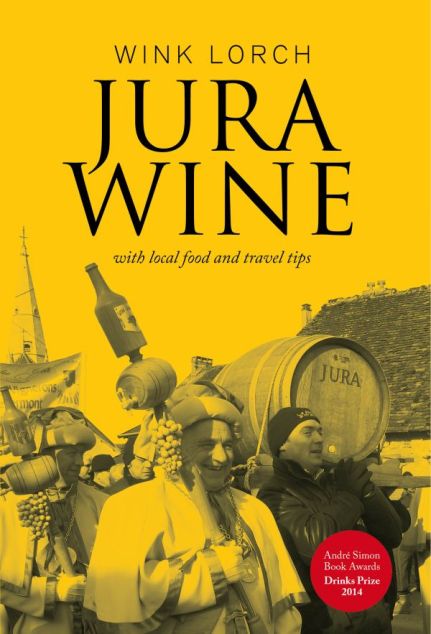I’ve long had a soft spot for the Labet family of Rotalier in the area south of Lons-le-Saunier, known as the Sud Revermont. Not only for them, but for their superbly crafted Chardonnays, tangy Savagnin Ouillé, classic Vins Jaunes and interesting Vin de Pailles. Since my first visit more than ten years ago, eldest son Julien has been on the scene, but now he and his siblings call the shots.
“Nous sommes en pleine effervescence!” Julien told me excitedly on the phone when I made the appointment to visit in January. I could understand the sense of fizzing (their Crémants can be excellent too), but my dictionary gives the correct translation of “We are buzzing”. The big change is that Alain and Josie Labet have officially retired at the end of last year, handing the reins over to Julien, his sister Charline (a trained oenologist, as is Julien) and brother Romain (whose focus is the vineyards). A new Domaine Labet is born.
Succession is rarely easy (more on some of the issues faced by other Jura estates soon), but there never seemed any doubt that the three children of Alain and Josie would follow these thoughtful vignerons into the family business.
Yet with Alain and Julien there were always two alpha males at play, locking horns over the family lunch or in the cellar. This, despite the fact that in their different approaches both men share an utter dedication and passion for preserving the ecology of the vineyards and making wines that both uphold Jura traditions, but can appeal to a market beyond the region. Julien is excited and keen to move on together with his sister and brother.
Respect for the vineyards
When I first met Alain Labet and visited his vineyards in and around the village of Rotalier, he explained that in the 1970s he had farmed the vineyards completely organically, along with Pierre Overnoy he was a pioneer at that time but, just as with Jean Macle of Château-Chalon, the work and risks became too much – he didn’t want to lose a crop. However, just like Jean, Alain worked the minimum possible with chemicals, and was very respectful of the local environment. Julien explained on this visit that his father would use herbicide under the vines because “he didn’t want to spend all his time on a tractor”. Many of the vineyards are on the typical local marl (a clay-limestone mix), that can be very heavy to work, but is prized vineyard terroir here.
When Julien took on three hectares of vines for his own personal estate in 2003 he gradually converted them to organics, later applying for certification which he received from Ecocert in 2010. These three hectares are now incorporated into the new Domaine Labet, and the siblings have embarked on an organic certification programme for the whole domaine, the main work to be done is to replace the use of herbicide with a mechanical weeding method. The estate has quite a large proportion of old vines of 50 plus years, and for the very old vines that are planted at high densities they intend to use a horse to work them. The family has recently purchased another plot of nearly a hectare bringing the total to nearly 13 hectares, reds form just a small part, around two hectares.
Thoughtful winemaking
Julien Labet took over the winemaking in 1997, initially working side by side with his father, he had previously worked both in Burgundy and in South Africa and was keen to introduce new or fairly new barrels for fermentation and ageing of the Chardonnays in particular, at the time something quite radical in the Jura. He explained to me that at this time the wines were usually a natural 13% alcohol and that the barrel element helped fill out the middle palate giving ‘gras’ as the French call it, meaning ‘fatness’ or richness. With climate warming they now regularly achieve 14-14.5% alcohol and Julien finds that he does not want so much new oak element now, and plans to move gradually to bigger oak, demi-muids (300 – 600l) and large foudres (15 hectolitres). The latter help maintain freshness and what Julien termed in French ‘tension’.
One of the differences between the two ranges of wines that that the family has produced over the past few vintages – the Domaine Labet range, overseen by Alain, and Domaine Julien Labet or Les Vins de Julien – were that the latter were often sulphur free with Julien attending certain natural wine fairs to promote his wines. In the future sibling-run Domaine Labet, there will be two ranges – a classic one retaining for now the existing label in particular for regular, long-term customers, and a ‘natural’ range, no doubt with interesting labels as Julien himself has used – zero sulphur if possible.
I found Julien’s attitude to the use of sulphur dioxide in winemaking refreshingly frank and sensible. And, although Charline wasn’t there on my visit, I tasted with her at last year’s “Le Nez dans Le Vert” organic wine fair, and the two work comfortably side-by-side with the same approach. Pre-bottling the domaine wines will have a small dose of SO2 added routinely, a safety measure for their customers’ sake. However, the domaine’s future ‘natural’ range will have no SO2 unless as happens with some wines it is necessary to prevent oxidation.
They use natural yeasts for all the wines, and they are no longer pumped, instead they use gravity and a mixture of compressed carbon dioxide with nitrogen to protect the wine in the hoses. In my experience of tasting with Julien, he loves the reductive approach, something that is almost essential for no or lower sulphur wine production, even if it can cause some notes in the wines that not everyone enjoys.
Selecting the favourites
In all, with the estate wines and Julien’s own wines in the past few years there have been about 30 different labels made from the 12 hectares, and there are no plans to reduce this range. It was Alain who pioneered making ouillé or topped up, rather than oxidative or traditional (in the Jura sense) Chardonnay in 1992, with what is today one of their biggest volume wines, Fleur de Chardonnay, at the time in foudres. The other big volume wine is the simple Chardonnay Cuvée Fleurs from a blend of five parcels with vines of different ages. The 2011 was tasting delicious with lovely floral and mineral characteristics along with apples on the palate. As often on previous tastings, my favourite Chardonnays were from the plot named Les Varrons planted with 65+ year old massal selection vines. I enjoyed both Julien’s no sulphur version from 2010, from very late picked grapes giving an almost sweet yellow fruit character (high in alcohol at over 14.5%), but with fresh acidity and spice to balance, and the domaine version from the same year, which was a touch more balanced with a mineral, stony character. We also tasted the domaine 2008 Les Varrons showing greater complexity and very exotic. Julien’s Fleur de Savagnin 2010 mainly from the well-known En Chalasse plot, was fabulous with a smoky lemon character on the nose leading to a ripe but tangy taste, almost like eating a fresh Meyer lemon (a taste I acquired on a visit to California). The grapes had 5 – 10% botrytis that would have accounted for that extra richness.
Our tasting of oxidative wines included Chardonnay Cuvée du Hasard (meaning ‘chance cuvée’). It has taken me many years to appreciate oxidative Chardonnay in particular, but I loved the 2008 Hasard from 60+ year old vines. A blend from different barrels, it is aged under a veil of yeast (as in Vin Jaune) for around three years. The result is an amazing intense aroma of cooked fruit and nuts with an equally intense palate, balanced by spices. The 2005 Vin Jaune was good and the Labets consider their Jaunes ready to drink when bottled, this is achieved with ageing mainly in warm conditions on a higher level of the cellar.
Onto sweet wines and we tasted a lovely 2010 late-harvest Savagnin Grains Fauves from grapes that were on the turn towards noble rot. Just two barrels were made and it has a delicious balance of nearly 15% alcohol with 12 g/l of sugar giving a lovely honeyed nose and sweetish intensity. I also really enjoyed Julien’s La Paille Perdue 2007 though whether the local authorities allow Julien to continue naming it this is in question as they don’t like the fact that he uses the word ‘Paille’ in the name. This is a non-official Vin de Paille and ironically Julien is amongst the very few to dry the grapes on straw (‘paille’ in French), in fact on organic straw in wooden boxes for around six months in the attic. Not officially approved because it is only 11.9% alcohol instead of the minimum 14% and correspondingly sweeter than usual with 169g of sugar. Usually their Vin de Paille (whether official or not) has around 70-75% Chardonnay, 20-25% Savagnin and a touch of Poulsard. However, in 2007 the mix was 55% Savagnin and 40% Chardonnay. A fabulously unctuous wine with honeyed spices.
We did not taste the Crémants or reds in a formal manner on this visit, but with a quickly put together lunch from the ever-hospitable Labets I really enjoyed a 100% Chardonnay Crémant made Extra Brut, and a pleasant, juicy no-SO2 Trousseau 2011, though so light that I mistook it for a Poulsard (whoops, but it was after a big tasting of whites!) – Julien pointed out that it was rounder and smoother than Poulsard. A few weeks later over the Percée weekend Julien’s superb Pinot Noir Les Varrons 2009 was a highlight for me, tasted in the press office.
My admiration for this estate only continues with the new generation taking over. My thanks to Alain and Josie for both the domaine and the new generation you nurtured so well.









